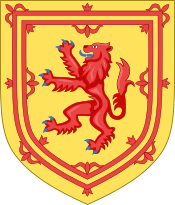Scoto-Norman
The term Scoto-Norman (also Franco-Scottish or Franco-Gaelic) is used to describe people, families, institutions and archaeological artifacts that are partly Scottish (in some sense) and partly Anglo-Norman (in some sense). It is used to refer to people or things of Norman, Anglo-Norman, French or even Flemish or Breton origin[1][2], but who are associated with Scotland in the Middle Ages like Scoto-Anglo-Saxon[3][4]. It is also used for any of these things where they exhibit syncretism between French or Anglo-French culture on the one hand, and Gaelic culture on the other.
For instance, the Kings of Scotland between the reign of the David I and the Stewart period are often described as Scoto-Norman. A classic case of Gaelic and French cultural syncretism would be Lochlann, Lord of Galloway, who used both a Gaelic (Lochlann) and French name (Roland), and kept followers of both languages. Another example of a Scoto-Norman, would be Robert the Bruce.
The term is used by historians as an alternative to Anglo-Norman when that term pertains to Scotland. It was first used in 1829, in P. F. Tytler's History of Scotland.[5][6]
